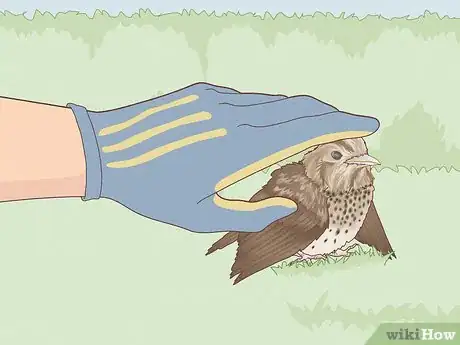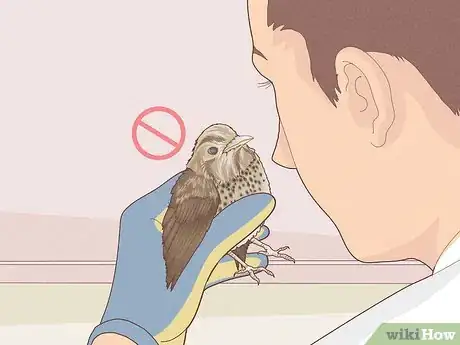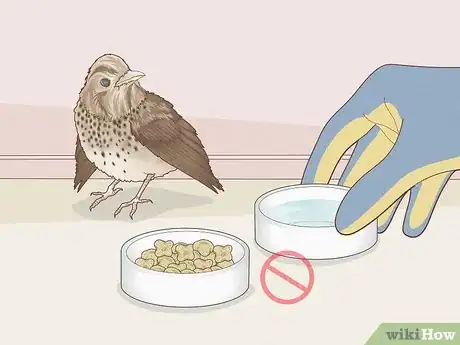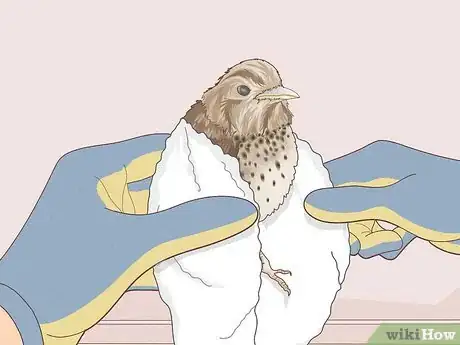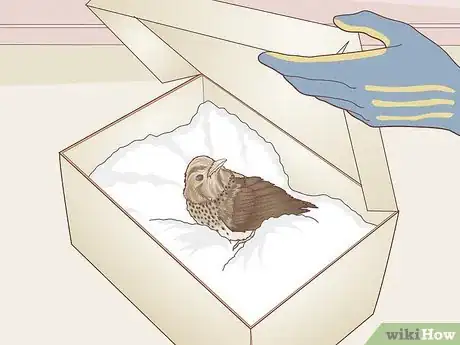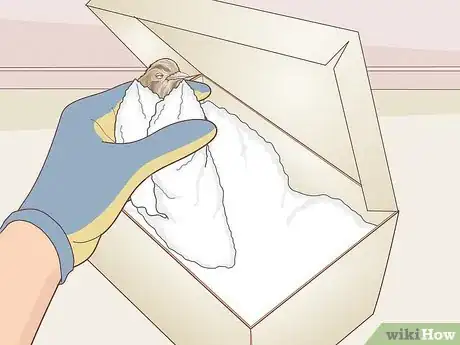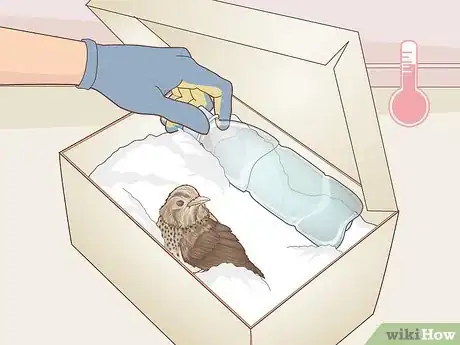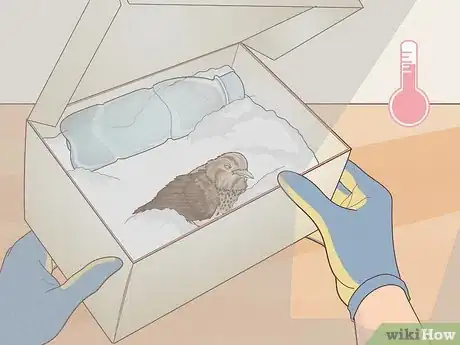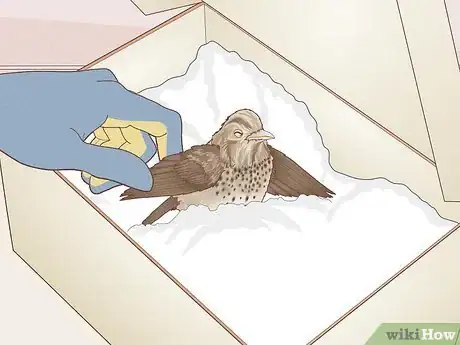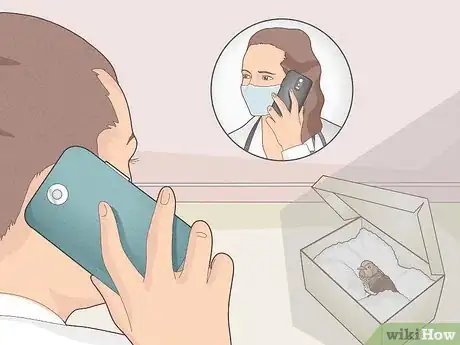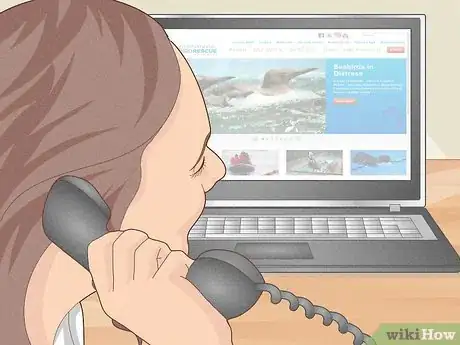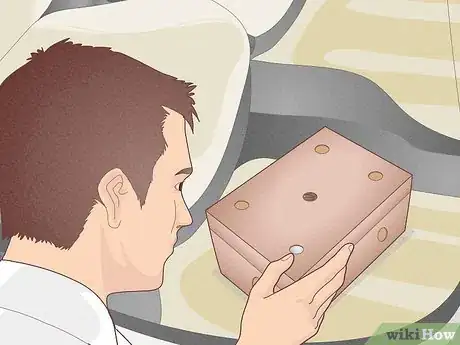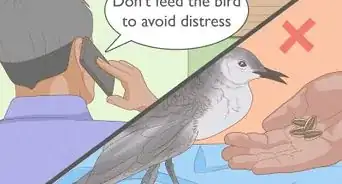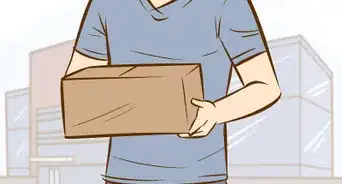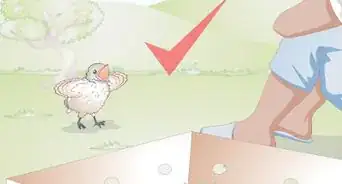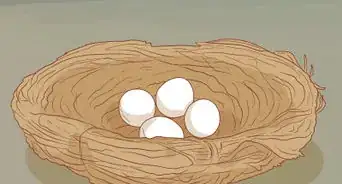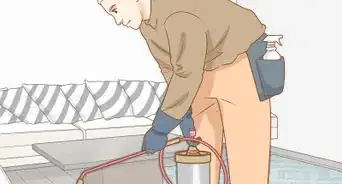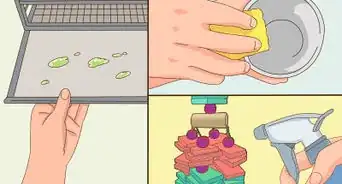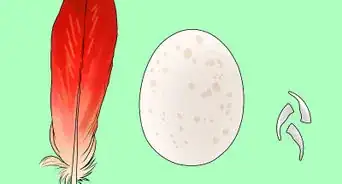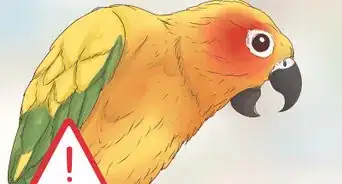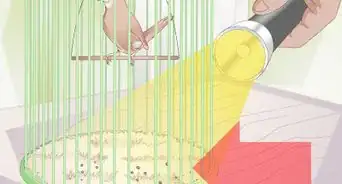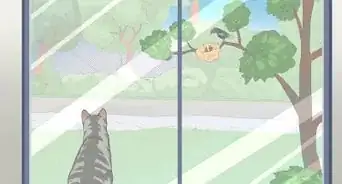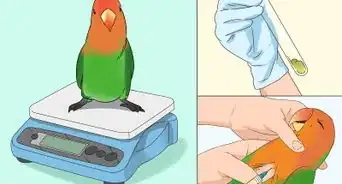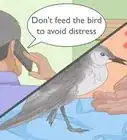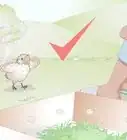This article was co-authored by Lauren Baker, DVM, PhD. Dr. Lauren Baker is a Veterinarian and Assistant Scientist at the University of Wisconsin-Madison. With over 10 years in veterinary medicine, she specializes in the concept of “one health,” which uses insights from veterinary medicine to help human medical research. She holds a Ph.D. in Comparative Biomedical Sciences, a Doctor of Veterinary Medicine, an MS in Comparative Biomedical Sciences, and a Bachelor’s degree in Psychology from the University of Wisconsin-Madison.
This article has been viewed 283,889 times.
Broken wings are traumatizing for birds, especially wild ones that often depend on flight for survival. If you find a bird with an injured wing, whether it is a wild or domestic bird, you’ll need to assess the situation quickly. Try to determine if you think the bird will be able to rehabilitate. If so, wrap the bird snugly in a clean towel and put it inside a shoebox. Make sure the bird is warm and out of reach from any other animals or children in the house. Call your vet and/or local wildlife rescue organizations to determine where to take the animal next.
Steps
Taking the Proper Precautions
-
1Wear gloves when handling the bird. Birds can carry a lot of gross diseases, so it’s important to protect yourself even when you’re trying to help the bird. Never pick up a wild bird with your bare hands. Wear protective gloves and wash your hands immediately after handling the bird. You should wear gloves even if it is a domestic pet bird that is injured, as hurt birds may be frantic and lash out at you if they are feeling vulnerable and in pain.[1]
- It’s best to use thick canvas or cloth gloves – like those used in gardening. These will be the most effective in protecting you from the bird’s beak and claws, as well as from any potential diseases the bird might be carrying.
- If you don’t have any gloves handy, try using a towel to pick up the bird.
- If the injured bird is a large bird of prey, you are best off not handling it at all. Instead, call the animal control or a bird rescue organization in your area.
-
2Avoid putting the bird too close to your face. Even small birds have sharp beaks and talons. Whenever you are handling an injured bird, always keep it away from your face to protect yourself. Even your own pet bird might snap at you if it is hurt and feeling scared.
- A bird with a broken wing will likely feel more vulnerable and might lash out at you with its beak or claws.
Advertisement -
3Refrain from giving the bird food or water. An injured bird will typically be too scared to eat or drink. You should try to take quick action to get the bird the help it needs, so you shouldn’t need to provide it with food or water in the short time the bird is in your care.[2]
- It’s easy for an injured bird to choke on water when it is force-fed. Don’t do this.
Protecting the Injured Bird
-
1Wrap the bird in a towel. Injured birds, whether wild or domestic, feel much better when they are wrapped up in something protective, like a towel. It will help the bird stay calm, and it will also keep the bird from moving more and hurting itself.[3]
- Try to protect the injured wing when you wrap the bird in the towel. Gently place the injured wing against the bird’s body (not bent in a funny way) and wrap the bird snugly in the towel.
-
2Put the bird into a shoebox. Place a towel on the bottom of a shoebox for added comfort, then put the bird on top of it. Make sure the box has a lid that you can close securely to ensure the bird doesn’t escape and hurt itself more.[4]
- For a larger bird, you may need to choose something larger to carry it in. Try a hard-sided cat carrier or a larger cardboard box.
- Make sure any box you put a bird in has some ventilation holes so that the bird can still breathe inside the box.
-
3Move the bird as little as possible. A bird with a broken wing (or other injury) should not be moved except when absolutely necessary, even if it is your pet bird. This will help prevent further injury for the bird.[5]
- Pick the bird up with a towel, wrap it in a towel, and place it in a shoebox. Then don’t move the bird again unless absolutely necessary.
-
4Provide an extra heat source. In the bird’s weakened state, it is very possible that it will need extra help staying warm. Try putting a warm water bottle in the box with the bird to provide some additional heat.[6]
- Make sure the water bottle is in a place where the bird can get away from it if it gets too hot. Since the bird can’t move around much while it is injured and wrapped in a towel, you should put the water bottle in the opposite end of the box and monitor the bird for signs of overheating.
- If the bird starts panting, remove the water bottle immediately. You’ll need to periodically remove the lid to the box to check and see if the bird is panting.
-
5Put the bird in a warm, safe place while you figure out what to do next. While you are deciding what course of action to take, put the injured bird in a safe place where it will be warm and out of harm’s way. Keep it somewhere dimly lit and quiet so the bird can feel more calm.[7]
- The bird should be kept away from small children or other animals who might attack it or accidentally injure it more.
Getting Professional Help
-
1Assess the bird’s injuries. Try to inspect the bird and determine the extent of its injuries. If the bird looks dazed, stunned, or unconscious, this could mean that the bird is in shock and is suffering from more injuries than just a broken wing. If the bird is alert – and even trying to get away from you – this is a good sign. Try to look for any visible blood or wounds that can help you assess the severity of the bird’s condition.[8]
- If you think the bird’s broken wing is too damaged to repair, or the bird appears to have other injuries as well, the bird may need to be euthanized.
- If the bird needs to be euthanized, you can take it to a vet for assistance or call the local animal control authorities.
-
2Contact a local veterinarian or avian specialist. For an injured domestic bird, call your personal vet for advice. If you don’t know what to do with an injured wild bird, you can also call your local vet to see what they recommend. Some vets offer free assistance (like antibiotics or life-saving surgery) to animals injured in the wild.[9]
- Your vet probably won’t be able to house a wild bird while it recovers (unless you pay for it), but they may be able to provide some sort of care or support.
-
3Call or talk to several bird rescues in your area. If you found an injured bird in the wild, you may need to contact a bird rescue organisation for help. Look online to find some in your area. They may be able to provide some medical assistance for your injured bird, but have no room to house or rehabilitate the bird. You should specifically ask them about what services they are able to offer: one-time medical assistance, housing, rehabilitation services, and continuous medical care throughout rehabilitation. You may need to ask several rescue organizations if they have room for the bird you found.
- You may need to call several agencies before you find one that is willing to help you. These rescues typically depend on public donations to function, so they may be running short on funding, supplies, or physical space.
-
4Take the bird to a rescue that doesn’t euthanize. If you’ve determined that the bird’s injuries don’t seem fatal, inquire about each rescue’s euthanization policy. Be sure to ask each rescue what their policy is specifically regarding birds with broken wings. Some organizations believe that birds who have broken wings can never be happy again without the ability to fly, and thus should be euthanized. Others think that it is quite possible for some birds to live a happy life after recovering from a broken wing.[10]
- You don’t want to go to all the trouble of helping a bird with a broken wing, only to have it euthanized by the rescue you take the bird to.
-
5Take the bird carefully to another location. Whether you take the bird to a vet or to an animal rescue, you’ll need to transport it safely to the next location. Make sure the lid of the box is securely closed so the bird can’t get out on the trip. Try to keep the box as still as possible.
- Put the box in the floorboard of the passenger seat of your car if you are driving. Otherwise, try to hold the box as still as possible.
References
- ↑ https://www.wvdnr.gov/wildlife/magazine/Archive/03Spring/Want_to_Lend_a_Helping_Hand.shtm
- ↑ http://wildbirdrehab.org/help-ifoundabird/
- ↑ http://www.birds.com/bird-care/injured/
- ↑ http://wildbirdrehab.org/help-ifoundabird/
- ↑ http://www.massaudubon.org/learn/nature-wildlife/birds/helping-injured-birds
- ↑ http://helpwildlife.co.uk/sick-or-injured-wildlife/brokenwings/
- ↑ http://www.birds.com/bird-care/injured/
- ↑ http://www.birds.com/bird-care/injured/
- ↑ http://www.faunarescue.org.au/bird-basic-treatment.htm
About This Article
To help a bird with a broken wing, start by putting on a pair of gloves to protect you from any germs the bird might be carrying. With gloves on, gently wrap the bird in a towel, which will help it calm down and prevent it from hurting itself further. Once you’ve wrapped the bird up, place another towel in a cardboard box and put the bird inside to keep it safe and comfortable. Avoid giving it food or water, since it will probably be too scared to eat or drink. When you’ve settled the bird in a box, call your local vet to ask for their advice. If they can’t help you, try contacting bird rescues in your area to see if they can take the bird in. For more tips from our Veterinary co-author, including how to provide extra heat for an injured bird, read on!
